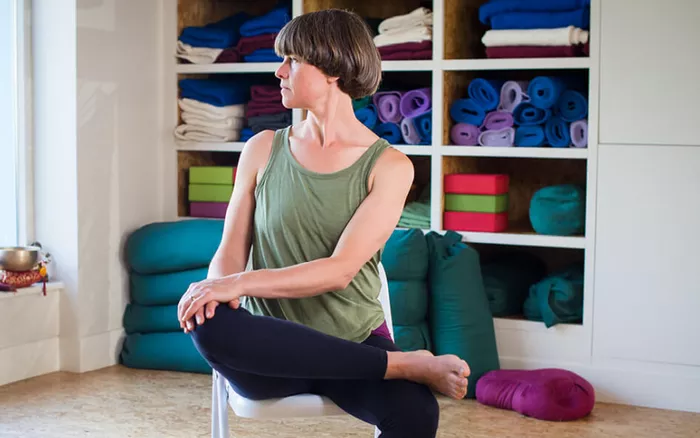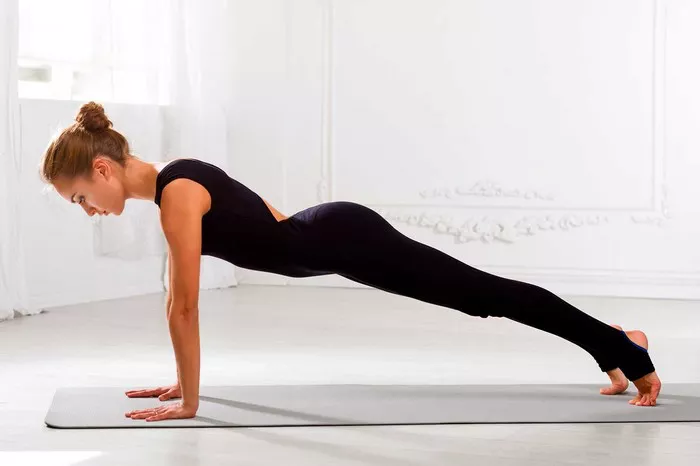n today’s fast-paced work environment, it’s easy to become glued to your desk for hours on end. The demands of modern office life often leave little room for physical activity, leading to a sedentary lifestyle that can negatively impact both your physical and mental well-being. However, incorporating small, manageable yoga exercises into your daily routine can counteract these effects. Desk yoga, which consists of simple stretches and poses that can be performed at your workstation, offers an effective solution for maintaining health and productivity.
Desk Yoga Poses
1. Seated Cat-Cow Stretch
The Cat-Cow stretch is a gentle way to warm up your spine and ease tension in your back and shoulders.
How to do it:
- Sit on the edge of your chair with your feet flat on the floor.
- Place your hands on your knees.
- On an inhale, arch your back and look up towards the ceiling, lifting your chest (Cow Pose).
- On an exhale, round your back and tuck your chin to your chest (Cat Pose).
- Repeat for 5-10 breaths, moving slowly and smoothly with each inhale and exhale.
2. Seated Forward Bend
This pose helps to stretch the back and shoulders, releasing tension accumulated from sitting.
How to do it:
- Sit on the edge of your chair with your feet hip-width apart and flat on the floor.
- Take a deep breath in and, as you exhale, hinge forward from your hips, reaching your hands towards the floor.
- Allow your head and neck to relax.
- Hold for 5-10 breaths, then slowly roll back up to a seated position.
3. Chair Pose
Chair Pose strengthens your legs and improves balance and focus.
How to do it:
- Stand up from your chair and position yourself in front of it, feet hip-width apart.
- Bend your knees and lower your hips as if you are going to sit back down, keeping your weight in your heels.
- Reach your arms overhead with your palms facing each other.
- Hold for 5-10 breaths, then stand back up.
4. Seated Twist
Twisting poses help to relieve tension in the spine and improve digestion.
How to do it:
- Sit sideways on your chair with your feet flat on the floor.
- Place your hands on the back of the chair.
- Inhale and lengthen your spine.
- Exhale and gently twist to your right, looking over your right shoulder.
- Hold for 5-10 breaths, then switch sides.
5. Eagle Arms
This pose stretches the shoulders and upper back, areas that often become tight from computer work.
How to do it:
- Sit on the edge of your chair with your feet flat on the floor.
- Extend your arms straight out in front of you.
- Cross your right arm over your left, then bend your elbows so that your palms face each other.
- If possible, bring your palms together. If not, simply place your hands on opposite shoulders.
- Lift your elbows to shoulder height and hold for 5-10 breaths, then switch sides.
6. Wrist and Finger Stretches
These stretches help to relieve tension in the wrists and fingers, which can be caused by typing.
How to do it:
- Extend your right arm in front of you, palm facing up.
- With your left hand, gently pull back on your fingers to stretch your wrist and forearm.
- Hold for 5-10 breaths, then switch sides.
- To stretch your fingers, make a fist with your right hand and then open your hand, spreading your fingers as wide as possible.
- Repeat 5-10 times, then switch sides.
7. Seated Pigeon Pose
This pose stretches the hips and glutes, areas that can become tight from prolonged sitting.
How to do it:
- Sit on the edge of your chair with your feet flat on the floor.
- Cross your right ankle over your left thigh, keeping your right foot flexed to protect your knee.
- Gently press down on your right knee to deepen the stretch.
- Hold for 5-10 breaths, then switch sides.
8. Standing Forward Fold
This pose helps to release tension in the back, neck, and shoulders while also stretching the hamstrings.
How to do it:
- Stand up from your chair with your feet hip-width apart.
- Take a deep breath in and, as you exhale, hinge forward from your hips, reaching your hands towards the floor.
- Allow your head and neck to relax.
- Hold for 5-10 breaths, then slowly roll back up to a standing position.
9. Neck Stretches
These stretches help to relieve tension in the neck and shoulders.
How to do it:
- Sit on the edge of your chair with your feet flat on the floor.
- Drop your right ear towards your right shoulder, feeling a stretch along the left side of your neck.
- Hold for 5-10 breaths, then switch sides.
- To deepen the stretch, gently place your right hand on the left side of your head and apply light pressure.
10. Seated Side Stretch
This pose stretches the sides of your body and improves flexibility in your spine.
How to do it:
- Sit on the edge of your chair with your feet flat on the floor.
- Reach your right arm up and over your head, bending to the left.
- Hold for 5-10 breaths, then switch sides.
11. Shoulder Rolls
This simple exercise helps to relieve tension in the shoulders and improve mobility.
How to do it:
- Sit on the edge of your chair with your feet flat on the floor.
- Roll your shoulders up towards your ears, then back and down.
- Repeat 10 times, then reverse the direction.
12. Ankle Circles
This exercise helps to improve circulation and relieve tension in your feet and ankles.
How to do it:
- Sit on the edge of your chair with your feet flat on the floor.
- Lift your right foot off the floor and rotate your ankle in a circular motion.
- Do 10 circles in each direction, then switch sides.
13. Seated Sun Salutations
This sequence combines several poses to provide a full-body stretch.
How to do it:
- Sit on the edge of your chair with your feet flat on the floor.
- Inhale and reach your arms overhead.
- Exhale and fold forward, reaching your hands towards the floor.
- Inhale and lift your torso halfway up, placing your hands on your shins.
- Exhale and fold forward again.
- Inhale and reach your arms overhead as you sit back up.
- Exhale and bring your hands to your heart.
14. Eye Exercises
These exercises help to reduce eye strain from staring at a computer screen.
How to do it:
- Sit on the edge of your chair with your feet flat on the floor.
- Focus on a distant object for 20 seconds.
- Then, focus on a nearby object for 20 seconds.
- Repeat 5-10 times.
- To relax your eyes further, close them and gently press your palms against them for 20 seconds.
15. Breathing Exercises
Deep breathing exercises help to reduce stress and improve focus.
How to do it:
- Sit on the edge of your chair with your feet flat on the floor.
- Close your eyes and take a deep breath in through your nose, filling your lungs completely.
- Hold your breath for a few seconds, then exhale slowly through your mouth.
- Repeat for 5-10 breaths.
See Also: 10 Best Ways To Use Yoga Blocks
Integrating Desk Yoga into Your Routine
Incorporating desk yoga into your daily routine can be simple and seamless. Here are some tips to help you make it a habit:
1. Set Reminders: Use a timer or an app to remind you to take a yoga break every hour. Even a few minutes of stretching can make a significant difference.
2. Create a Routine: Designate specific times during the day for your desk yoga practice, such as first thing in the morning, during lunch, and in the afternoon.
3. Stay Consistent: Consistency is key to reaping the benefits of desk yoga. Aim to practice every day, even if it’s just for a few minutes.
4. Customize Your Practice: Choose the poses that feel best for your body and your work environment. Not every pose will be suitable for everyone, so listen to your body and adjust as needed.
5. Encourage Colleagues: Share the benefits of desk yoga with your coworkers and encourage them to join you. Practicing together can create a more supportive and health-conscious workplace.
6. Stay Mindful: Focus on your breath and the sensations in your body as you practice. This mindfulness can help to enhance the physical and mental benefits of yoga.
Conclusion
Desk yoga is a simple, effective way to improve your physical and mental well-being in the workplace. By incorporating these poses and exercises into your daily routine, you can counteract the negative effects of prolonged sitting, reduce stress, and boost your overall health. Whether you’re new to yoga or an experienced practitioner, desk yoga offers a convenient and accessible way to stay active and mindful throughout your workday. So take a break, stretch, and breathe – your body and mind will thank you.
























